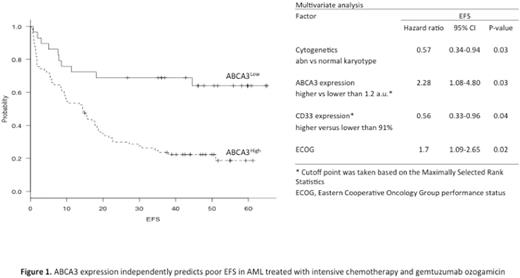Abstract
Background. The ATP binding cassette transporter 3 (ABCA3) has been recently found to induce a significant reduction in cytotoxicity following exposure to anthracyclines, mitoxantrone, etoposide, Ara-C, vincristine, and rituximab. ABCA3 acts through the modulation of multivesicular bodies (MVB) and contributes to drug sequestration in late endosomal organelles, i.e. MVB and lysosomes. Studies having investigated the prognostic impact of ABCA3 expression in AML have yielded conflicting results as ABCA3 expression has both been reported to exert unfavorable or neutral effects on patient outcomes. In addition, the small sample size of these studies precluded the use of multivariate analyses.
Methods. Our goal was to investigate the prognostic impact of ABCA3 expression in adult patients with AML treated with IC with or without gemtuzumab ozogamicin (GO). To this end we investigated the relationship between ABCA3 expression and EFS in a representative series of 221 AML homogeneously treated in the ALFA-0701 trial. qRTPCR amplification of conserved ABCA3 mRNA sequences, as identified with FasterDB database, was performed with GUS and ABL as reference genes. Primer sets were complementary to conserved ABCA3 exons 6-7 and exon 19-20 junctions. Patients were given a 3+7 induction course without (control group, n=110) or with fractionated intravenous GO (n=111) (Castaigne S, Lancet 2012; 379:1508-1516).
Results. Among the 278 randomized patients, 221 had available bone-marrow diagnostic samples with high-quality RNA. The same benefits associated with GO were observed in the 221 patients from the present study as in the entire trial population. Overall, median age, CR rate, relapse rate, median follow-up, 3-years EFS were 62.1 years, 76.5%, 66%, 47.45 months, 28±3%, respectively. There was no significant difference in the level of ABCA3 expression between responders and non-responders. In the 169 responders, ABCA3 expression at diagnosis was more than 3-fold higher in the 111 remitters who subsequently relapsed than in the 58 patients who remained in persistent CR (p=0.033). The level of ABCA3 expression was significantly lower in ELN favorable group than in intermediate and adverse risk AML (p= 0.004) and negatively correlated with CD33 expression (R=-0.272, p<10-4). Through univariate analysis, higher ABCA3 expression was associated with shorter EFS (3-years: 22±3 vs 45±7 % p=0.002). Multivariate analysis identified age, treatment arm, and ELN risk group as independent prognostic factors for EFS. In the control group, there was no significant association between ABCA3 expression and CR rate, relapse rate, and EFS. In the 111 patients within the GO arm, there was no significant difference in the level of ABCA3 expression between responders and non-responder whereas in the 89 responders, ABCA3 expression at diagnosis was more than 7-fold higher in the 53 remitters who subsequently relapsed than in the 36 patients who remained in persistent CR (p=0.006). Through univariate analysis, higher ABCA3 expression was associated with shorter EFS (3-years: 22±5 vs 64±9 % p=0.0002). Multivariate analysis identified ABCA3 expression, cytogenetics, CD33 expression, and ECOG as independent prognostic factors for EFS (Figure 1).
Conclusion. WhileABCB1 has been previously found to attenuate GO-induced cytotoxicity in AML cells (Walter RB, Blood 2003; 102:1466-1473), present results indicate that higher ABCA3 expression independently predicts poor outcome in AML patients treated with fractionated GO and intensive chemotherapy (IC). GO is an anti-CD33 antibody carrying a toxic calicheamicin derivative that, after hydrolytic release within lysosomal vesicles, induces DNA strand breaks, apoptosis, and cell death. Whether the clinical effect of ABCA3 expression relies on the modulation of CD33 internalization, calicheamicin release or combination thereof is under investigation. Finally our results encourage inhibiting ABCA3, such as with indomethacin, in order to overcome drug resistance in AML treated with GO-IC.
Thomas:Pfizer: Consultancy.
Author notes
Asterisk with author names denotes non-ASH members.


This feature is available to Subscribers Only
Sign In or Create an Account Close Modal